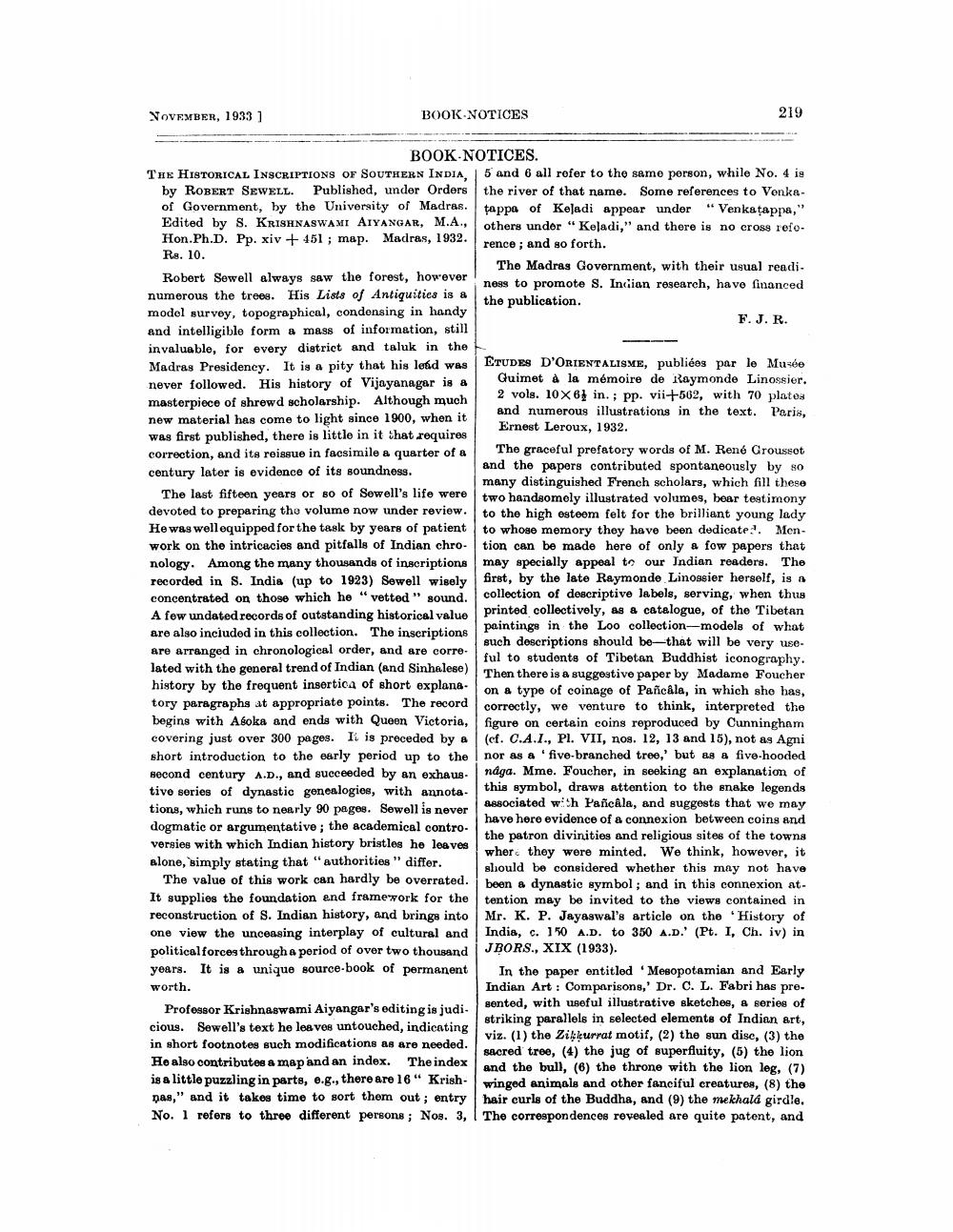________________
NOVEMBER, 1933 ]
BOOK NOTICES
219
BOOK NOTICES. THE HISTORICAL INSCRIPTIONS OF SOUTHERN INDIA, 5 and 6 all refer to the same person, while No. 4 is
by ROBERT SEWELL. Publishod, under Orders the river of that name. Some references to Vonke. of Government, by the University of Madras. tappa of Keladi appear under "Venkatappa," Edited by S. KRISHNASWAMI AIYANGAR, M.A.,
others under "Keladi," and there is no cross refoHon.Ph.D. Pp. xiv + 451 ; map. Madras, 1932.
rence; and so forth. Rs. 10.
The Madras Government, with their usual readi. Robert Sewell always saw the forest, however!
ness to promote S. Inciian research, havo financed numerous the trees. His Lists of Antiquities is a
the publication. model survey, topographical, condensing in handy
F.J. R. and intelligible form a mass of information, still invaluable, for every district and taluk in the Madras Presidency. It is a pity that his lead was ETUDES D'ORIENTALISME, publiées par le Musée never followed. His history of Vijayanagar is a
Guimet à la mémoire de Raymonde Linossier.
2 vols. 10 X 6 in.; pp. vii+502, with 70 plates masterpiece of shrewd scholarship. Although much
and numerous illustrations in the text. Paris, new material has come to light since 1900, when it
Ernest Leroux, 1932. was first published, there is little in it that requires correction, and its reissue in facsimile a quarter of a The graceful prefatory words of M. René Croussot
and the papers contributed spontaneously by so century later is evidence of its soundness.
many distinguished French scholars, which fill these The last fifteen years or so of Sewell's life were
two handsomely illustrated volumes, bear testimony devoted to preparing the volume now under review. to the high esteem felt for the brilliant young lady He was well equipped for the task by years of patient to whose memory they have been dedicate.. Menwork on the intricacies and pitfalls of Indian chro. tion can be made here of only & fow papers that nology. Among the many thousands of inscriptions may specially appeal to our Indian readers. The recorded in S. India (up to 1923) Sewell wisely
first, by the late Raymonde Linossier herself, is a concentrated on those which he "vetted" sound.
collection of descriptive labels, serving, when thus A few undated records of outstanding historical value
printed collectively, as & catalogue, of the Tibetan are also included in this collection. The inscriptions
paintings in the Loo collection--models of what
such descriptions should be-that will be very use. are arranged in chronological order, and are corre.
ful to students of Tibetan Buddhist iconography. lated with the general trend of Indian (and Sinhalese)
Then there is a suggestive paper by Madame Foucher history by the frequent insertice of short explana
on a type of coinage of Pancala, in which she has, tory paragraphs at appropriate points. The record
correctly, we venture to think, interpreted the egins with Aboka ond ends with Queen Victoria, figure on certain coins reproduced by Cunningham covering just over 300 pages. It is proceded by a (cf. C.A.I., Pl. VII, nos. 12, 13 and 15), not as Agni short introduction to the early period up to the nor as a 'five-branched tree,' but 88 & five-hooded second century A.D., and succeeded by an exhaus någa. Mme. Foucher, in seeking an explanation of tive series of dynastic genealogies, with annota.
this symbol, draws attention to the snake legends tions, which runs to nearly 90 pages. Sewell is never
Associated wh Pancala, and suggests that we may
have here evidence of a connexion between coins and dogmatic or argumentative; the academical contro.
the patron divinities and religious sites of the towns versies with which Indian history bristles he leaves
where they were minted. We think, however, it alone, simply stating that "authorities " differ.
should be considered whether this may not have The value of this work can hardly be overrated.
been a dynastic symbol ; and in this connexion at. It supplies the foundation and framework for the tention may be invited to the views contained in reconstruction of S. Indian history, and brings into Mr. K. P. Jayaswal's article on the History of one view the unceasing interplay of cultural and India, c. 150 A.D. to 350 A.D.' (Pt. I, Ch. iv) in politicalforces through a period of over two thousand JBORS., XIX (1933). years. It is a unique source-book of permanent In the paper entitled 'Mesopotamian and Early worth.
Indian Art: Comparisons,' Dr. C. L. Fabri has pre. Professor Krishnaswami Aiyangar's editing is judi.
sented, with useful illustrative sketches, & series of
striking parallels in selected elements of Indian art, cious. Sewell's text he leaves untouched, indicating
viz. (1) the Ziklurrat motif, (2) the sun disc, (3) the in short footnotes such modifications as are needed.
sacred tree, (4) the jug of superfluity, (5) the lion He also contributes a map and an index. The index
and the bull, (6) the throne with the lion leg, (7) is a little puzzling in parte, 0.g., there are 16" Krish- winged animals and other fanciful creatures, (8) the nas," and it takes time to sort them out; entry hair curls of the Buddha, and (9) the mekhalá girdle. No. 1 refers to three different persons ; Nos. 3, The correspondences revealed are quite patent, and




